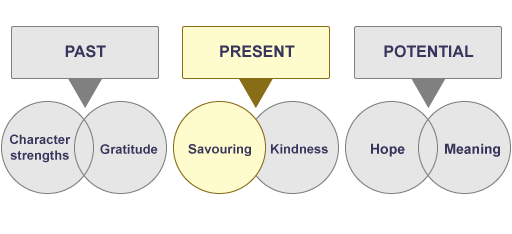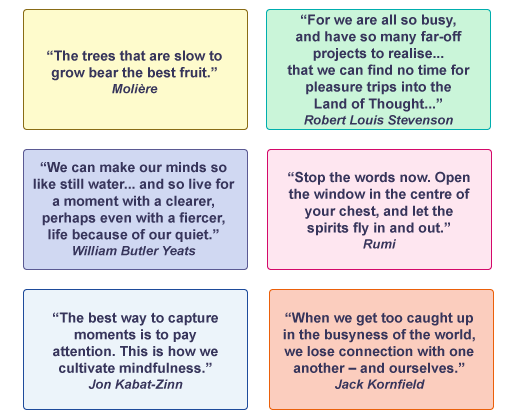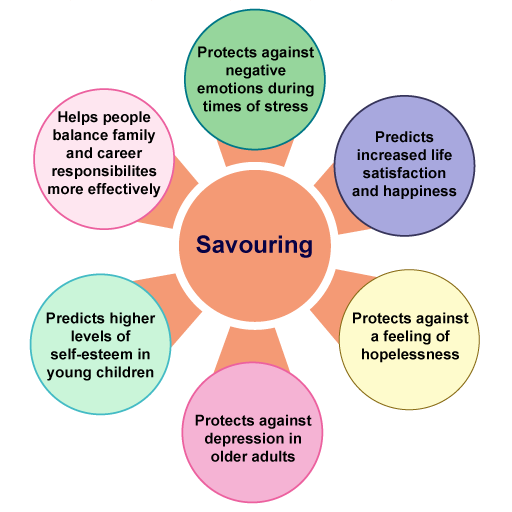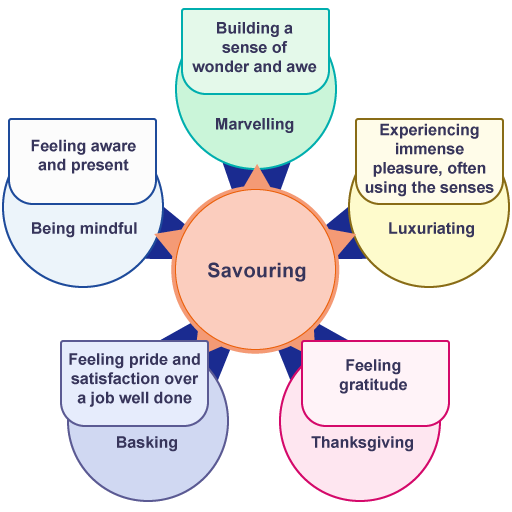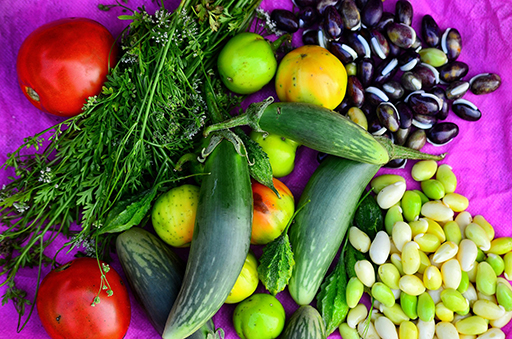Use 'Print preview' to check the number of pages and printer settings.
Print functionality varies between browsers.
Printable page generated Saturday, 22 November 2025, 3:55 PM
Unit 4: Savouring
The third of six themes
Throughout this course you are introduced to some of the ways you can boost your happiness and wellbeing, and that of your children, using six key themes that have been shown to improve wellbeing through the way we think about the past, present and future potential.
The third of these six themes is illustrated in the diagram below.
For this third theme, you are shown some practical activities that you can try at home. The benefits of these have all been supported scientifically and can be attempted by yourself during the course. They can also be adapted to work with children of all ages within the home. Being a good role model to our children is also a great way to help enhance their wellbeing.
 Mindful minute
Mindful minute
To start each unit, it is helpful to try to switch off from what has been happening in your day and greet your learning from a place of relaxation.
The following exercise can be a way of doing this, so please feel free to try this. Alternatively, you may have your own way of switching off from the distractions of your day, like making a hot drink or putting on some calming music.
Sit in a comfortable position with your hands resting on your lap. Try to keep your back, neck and head straight and place both of your feet flat on the floor.
Bring your attention to your breath and consciously try to relax your shoulders. Imagine that the muscles in your shoulders are melting into your body and breathe deeply into your belly so that you can feel it expanding.
Press the button below which will set a timer for 1 minute. Close your eyes and continue to focus on your breathing and relaxing your shoulders. It is normal for your mind to wonder, and when this happens try to gently bring it back to your breathing and relaxing. After a minute you will hear a buzzer. Open your eyes and continue with the course.
4.1 What is savouring and how can it help you and your family?
So far, the first three units have looked at areas in positive psychology that can improve our wellbeing with an emphasis on how we think about the past.
In this fourth unit, we move you towards an emphasis on the present by introducing you to this next theme of savouring.
 Savour the moments in life
Savour the moments in life
In this video Michelle introduces you to savouring and discusses what this is and why positive psychologists are interested in helping individuals to feel more motivated to savour more of the little moments in life.

Transcript
 More of the little moments in life
More of the little moments in life
Which of the quotes above do you most relate to and why?
Note your thoughts in the text box below.
Many families have found in recent years that their lives feel very hectic and busy. Perhaps you may feel like this at times and find yourself feeling that you are spreading yourself too thinly over the day.
Modern technology has enabled the world to become more ‘instant’ and this can increase pressures on families to balance work, home and social life. This can lead to feeling that you are not achieving many things well and that you are missing out on living life fully as you don’t have time to ‘take it all in’.
Many families look forward to the weekend or a longed-for holiday to take the time to slow down, relax and savour time together. This process allows individuals to pause and feel more positive emotions in the present moment.
Researchers in the field of positive psychology have found that making an effort to consciously carry out savouring exercises can help individuals to create an increasing spiral of positive emotions and experience more of the richness of life. This can expand your thoughts and behaviours, promoting creativity, social connection and resilience.
Savouring is the name for a simple practice involving trying to enjoy, feel, appreciate and extend the positive emotions of your experience. It is common to use our five senses of sight, sound, smell, touch and taste to savour something that gives us pleasure. Many experiences in life can be savoured, from nature, art, sport, entertainment, reading, eating and creating.
 Savouring a positive sensory experience
Savouring a positive sensory experience
Can you think of any examples where you have savoured a positive sensory experience?
As an example, you may enjoy the aroma and taste of a steaming hot cup of coffee in the morning as it makes you feel calm, comforted and ready to start your day.
Note one of your favourite moments of savouring in the text box below.
4.2 Benefits of savouring for families
Numerous benefits have been found through research studies in recent years in those who practice savouring on a regular basis. The diagram above highlights some of those benefits.
Savouring has been shown to enhance more positive emotions and build relationships as well as helping to protect against negative emotions. This can be of particular help when dealing with stressful situations within the family.
A leading researcher into savouring, Professor Fred Bryant at Loyola University Chicago, suggests that savouring is the “glue that bonds people together, and it is essential to prolonging relationships. People who savour together stay together”.
4.3 How to use savouring with your family to enhance wellbeing
There has been some preliminary research on mothers and children that found children may model their ways of savouring on their mothers.
This may suggest that if adult family members are practising savouring and seeing benefits, their children may copy them and also experience these positive effects.
 The Sound of Music
The Sound of Music
Watch this video clip, taken from the popular 1960’s film Sound of Music, as an example of the benefits of savouring in song.
 Ideas to help you to slow down
Ideas to help you to slow down
If you feel that you are living life at a fast speed and struggle to find much time to slow down and ‘smell the roses’ with your family, you may find some of these strategies helpful:
- Little steps – try to find spare minutes in your day when you can pause for a minute or two and take some deep breaths. Perhaps you could play a favourite song through headphones on your commute to work or stroke your pet for an extra minute.
- Consider reducing time as a family looking at your mobile phone and using social media.
- Try to get outside more and immerse yourself in nature.
- Find some time to be on your own without having to speak to anyone as often as possible, this can be very restorative.
- Try not to over stretch yourself and feel more comfortable with saying no.
- Before going to bed try to go outside and look up at the stars. Contemplate with awe how most stars are between 1 and 10 billion years old!
Which strategy do you think you would find the easiest to carry out?
Try to commit to carrying this out over the next 24 hours. Reflect on how this made you feel.
Note your thoughts in the text box below.
You can try diverse ways of savouring in your daily life that can help you to experience different emotions.
 Distinct types of savouring
Distinct types of savouring
Which of the distinct types of savouring shown in the diagram above do you find yourself most attracted to?
Can you think of any specific ways that you can incorporate these different types of savouring into family life?
Note your thoughts in the text box below
4.4 Go on a sensory walk
Going outside for a walk is a very simple way to experience savouring.
It also has other benefits that boost wellbeing, such as exercise, exposure to the sun, fresh air etc., so is an excellent way to boost your mood.
 A walk with your family
A walk with your family
Plan to go on a walk with your family (or this can be done on your own) for at least 20 minutes.
As you are walking, one by one, go through your five senses of:
- Sight
- Sound
- Touch
- Taste
- Smell.
Share your thoughts and feelings together about what you are experiencing.
Reflect on how you feel after your walk and make a note of this in the text box below.
4.5 Enjoy a mindful meal
Mealtimes in families can be rushed and fraught when trying to accommodate different preferences.
The next activity offers an opportunity to slow down and develop a more compassionate and nourishing relationship with food.
 A relationship with food
A relationship with food
This exercise can be done with your family when sharing a meal, or alone.
Before eating, look at your food and take in what you feel about the food through your senses:
- Does the food look appetising?
- Is it hot or cold?
- Does it have a pleasant aroma?
- What do you think about the texture of the food?
- Can you hear the food sizzling?
When eating the food, place it in your mouth and let it sit for a moment before chewing:
- How does it feel?
- Can you taste any specific flavours?
- Is it sweet or savoury?
- Does it feel hot or cold?
- Is your tongue salivating?
When you chew and swallow your food consider the texture and taste and how you feel after eating it.
Do you feel thankful for the food? Share your experiences with your family.
Note your thoughts in the text box below.
4.6 Create a self-care box
Here is another exercise that can be carried out to help you and your family to find more moments to savour, particularly when feeling overwhelmed and in need of comfort.
It also offers the opportunity to practise the character strength of kindness to others if given as a gift.
 A self-care box
A self-care box
Consider making a self-care box for yourself and for family members.
Fill the box with items that you feel will bring pleasure, comfort or joy. These items will be personal to you, but you may want to consider some of the ideas below:
- Aromatherapy relaxation/sleep spray
- Beautiful stone
- Body brush
- Chocolate
- Face pack
- Family photograph
- Favourite magazine
- Favourite poem
- Fluffy socks
- Gratitude letter from your family
- Hand cream
- Herbal teas
- Lip balm.
- Mindful colouring book
- Playlist of favourite songs
- Puzzle book
- Scented candle
Consider using an item from your self-care box when you feel you are in need of a moment of peace and would like to improve your mood.
Consider giving self-care boxes as gifts to those you love.
Note your thoughts on who you might give these boxes to in the text box below
4.7 Summary
In this unit you have explored the benefits of slowing down and looked at some ideas to help you feel motivated to take time to savour the little moments in life to feel more present.
In the next unit, you continue with this focus on being more present by exploring the subject of kindness.
 Further resources
Further resources
Bryant, F. B., & Veroff, J. (2007) Savoring: A New Model of Positive Experience, Mahwah, NJ: Erlbaum. |
Encyclopedia of An Ordinary Life: A Memoir – Amy Krouse Rosenthal. |
Savour: Mindful Eating, Mindful Life – Thich Nhat Hanh and Lilian Cheung. |
Now go to Unit 5: Kindness, where you explore the fourth of our six principles.
References
Bryant, F. (2003) 'Savoring Beliefs Inventory (SBI): A scale for measuring beliefs about savouring', Journal of Mental Health, 12(2), pp.175-196.
Bryant, F. B. & Veroff, J. (2007) Savoring: A new model of positive experience, Mahwah, NJ, Lawrence Erlbaum Associates.
Bryant, F.B. (2021) ‘Current Progress and Future Directions for Theory and Research on Savoring’, Frontiers in psychology, 12, pp. 771698–771698. doi:10.3389/fpsyg.2021.771698.
Camgoz, S.M. (2014) 'The role of savoring in work-family conflict', Social Behavior and Personality: an international journal, 42(2), pp.177-188.
Chen, J. & Zhou, L. (2017) 'Savoring as a moderator between positive life events and hopelessness depressio', Social Behavior and Personality: an international journal, 45(8), pp.1337-1344.
Fredrick, J.W., Mancini, K.J., & Luebbe, A.M. (2019) 'Maternal enhancing responses to adolescents’ positive affect: Associations with adolescents’ positive affect regulation and depression', Soc. Dev, 28, 290–305. doi: 10.1111/sode.12326.
Moran, K.M., Root, A.E., Vizy, B.K., Wilson, T.K., & Gentzler, A.L. (2019) 'Maternal socialization of children’s positive affect regulation: Associations with children’s savoring, dampening, and depressive symptoms', Soc. Dev, 28, 306–322. doi: 10.1111/sode.12338.
Smith, J.L. & Bryant, F.B. (2017) Savoring and well-being: Mapping the cognitive-emotional terrain of the happy mind. In The happy mind: Cognitive contributions to well-being , pp. 139-156, Springer, Cham.
Smith, J.L. & Hollinger-Smith, L. (2015) 'Savoring, resilience, and psychological well-being in older adults', Aging and Mental Health, 19(3), pp.192-200.
Tugade, M.M. & Fredrickson, B.L. (2007) ‘Regulation of Positive Emotions: Emotion Regulation Strategies that Promote Resilience’, Journal of Happiness Studies, 8(3), pp. 311–333. doi:10.1007/s10902-006-9015-4.
Zautra, A.J., Affleck, G.G., Tennen, H., Reich, J.W. & Davis, M.C. (2005) 'Dynamic approaches to emotions and stress in everyday life: Bolger and Zuckerman reloaded with positive as well as negative affects', Journal of Personality, 73(6), pp.1511-1538.
